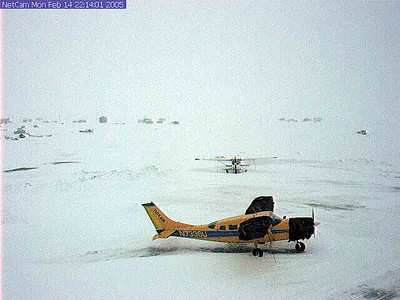FAA Report Recommends Initiatives
The FAA has released recommendations on how to increase aviation safety in Alaska after a yearlong, sweeping examination of safety issues specific to the challenges of flying in Alaska, where more than 80 percent of its communities are accessible only by air.

Among the recommendations are: increasing and improving weather data reporting and forecasting, expanding satellite-based Automatic Dependent Surveillance-Broadcast (ADS-B) air-traffic control coverage to more areas, and improving navigation charting. The FAA will now begin developing a roadmap for implementing the recommendations in the near- and mid-term, focusing on initiatives with the greatest safety benefits.
“Alaska depends on aviation more than any other state, and we are committed to doing everything possible to make flying safer,” said FAA Administrator Steve Dickson. “We teamed up with the flying community and together developed this comprehensive blueprint for our safety work going forward.”
The report made five primary recommendations:
- Install Automated Weather Observing Systems (AWOS) at airports that don’t have them and where the systems would have the biggest safety benefit, and continue testing a new technology called Visual Weather Observation System (VWOS).
- Develop a comprehensive Alaska airspace navigation strategy, including creating lower-altitude flight routes and improving GPS backup systems.
- Continue a collaborative working group initiative in partnership with the Aircraft Owners and Pilots Association that’s verifying and adding mountain pass information on aeronautical charts, and continue to hold FAA bi-annual charting meetings, allocating time for Alaska-specific discussions.
- Continue efforts to expand ADS-B services to areas that don’t have it, and continue outreach efforts to encourage operators to equip their aircraft with ADS-B.
- Continue existing safety outreach programs and look for new opportunities where different FAA divisions could work together to address safety issues from multiple perspectives.

The FAA will develop a draft roadmap by mid-February 2022, identify the resources necessary to implement it and will then seek aviation stakeholder feedback on the roadmap through May 2022. The FAA will continue those initiatives already underway and will begin to incorporate aspects of the new initiatives by summer 2022. A progress report will be submitted to stakeholders by September 30, 2022.
In October 2020, the FAA Administrator launched the FAA Alaska Aviation Safety Initiative (FAASI) at a safety summit to discuss recommendations the National Transportation Safety Board made about Alaska charter and commuter operations. FAA Administrator Dickson then directed the formation of a group of FAA experts to focus on safety issues particular to Alaska, which resulted in the safety initiative.
Throughout the spring and summer of 2021, the FAA hosted 12 virtual meetings with aviation stakeholders — including pilots, trade associations, airports and state officials — to get their feedback on current and planned safety efforts in Alaska. Discussions addressed which FAA initiatives and programs are producing desired results, where improvements are needed, and what else the agency should consider to have a greater safety impact.
In addition to identifying key safety needs, the report cites successful FAA initiatives, including the agency’s weather-camera system and efforts that greatly reduced safety incidents around Bethel Airport.
The report also notes FAA’s plans to install additional AWOS systems at airports where airport sponsors request them using funding from FAA’s Airport Improvement Program.
 ANN's Daily Aero-Term (04.26.24): DETRESFA (Distress Phrase)
ANN's Daily Aero-Term (04.26.24): DETRESFA (Distress Phrase) Aero-News: Quote of the Day (04.26.24)
Aero-News: Quote of the Day (04.26.24) ANN's Daily Aero-Term (04.27.24): Direct
ANN's Daily Aero-Term (04.27.24): Direct ANN's Daily Aero-Linx (04.27.24)
ANN's Daily Aero-Linx (04.27.24) Aero-News: Quote of the Day (04.27.24)
Aero-News: Quote of the Day (04.27.24)




